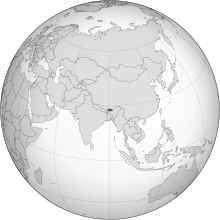Cannabis in Bhutan
 Location of Bhutan (dark green) | |
| Medicinal | Illegal |
|---|---|
| Recreational | Illegal |
Cannabis in Bhutan is illegal, but grows prolifically in the country and has multiple traditional uses, such as feeding pigs and producing textiles.[1]
Popularization
Awareness of cannabis as a drug seems limited in Bhutan, with some authorities tracing its arrival to the legalization of television in 1999; prior to that point, cannabis was mostly thought of as a fodder to fatten pigs.[2][3] The International Narcotics Control Board noted in 2002 that Bhutan had no history of cannabis abuse, but the government had recently raised concerns about drug abuse, particularly by the young, and taken an interest in eradicating wild cannabis and counseling drug users.[4]
Enforcement
Bhutan's first arrest for drug abuse occurred in 1989 in Gelephu, where a man was arrested for abusing cannabis.[5]
In 2010 the Bhutanese government seized 4 kg of cannabis; in 2011 this increased to 75 kg.[6]
Textiles
Though the wild nettle is the more common source of traditional textiles, cannabis has also been used for its fibre, and is called kenam in the Dzongkha language.[7]
References
- ^ "Bhutan" (PDF). UNODC: South Asia Regional Profile. September 2005. Retrieved 22 February 2024.
- ^ "Fast forward into trouble". The Guardian. 13 June 2003. Retrieved 22 February 2024.
- ^ Lawson, Alastair (30 May 2002). "Bhutan's growing cannabis problem". BBC News. Retrieved 22 February 2024.
- ^ Report of the International Narcotics Control Board for 2002. United Nations Publications. 2003. pp. 57–. ISBN 978-92-1-148154-9. OCLC 1345647094. Retrieved 22 February 2024.
- ^ "41 dead and counting: Bhutan's growing Drug problem". The Bhutanese. 2013. Retrieved 22 February 2024.
- ^ "Chapter III: Analysis of the World Situation: C. Asia" (PDF). Report of the International Narcotics Control Board for 2012. United Nations. January 2013. p. 86. ISBN 978-92-1-148270-6. ISSN 0257-3717.
- ^ Karin Altmann (1 January 2016). Fabric of Life - Textile Arts in Bhutan: Culture, Tradition and Transformation. De Gruyter. pp. 235–. ISBN 978-3-11-042861-2.
